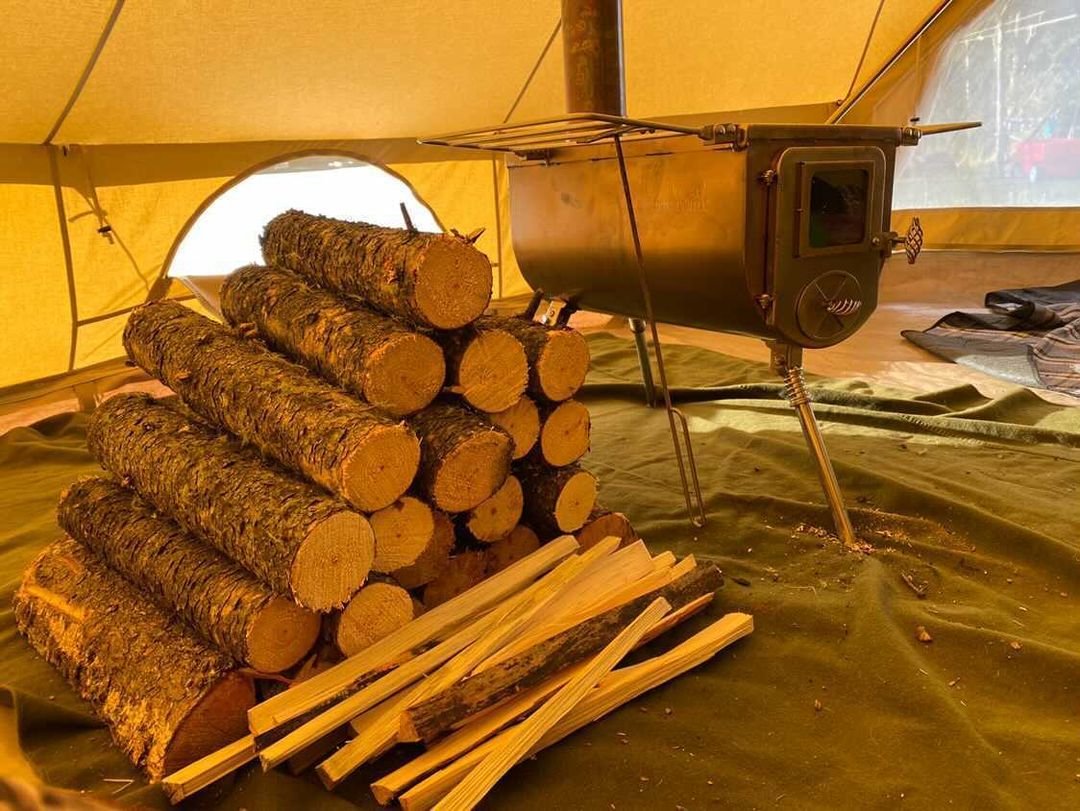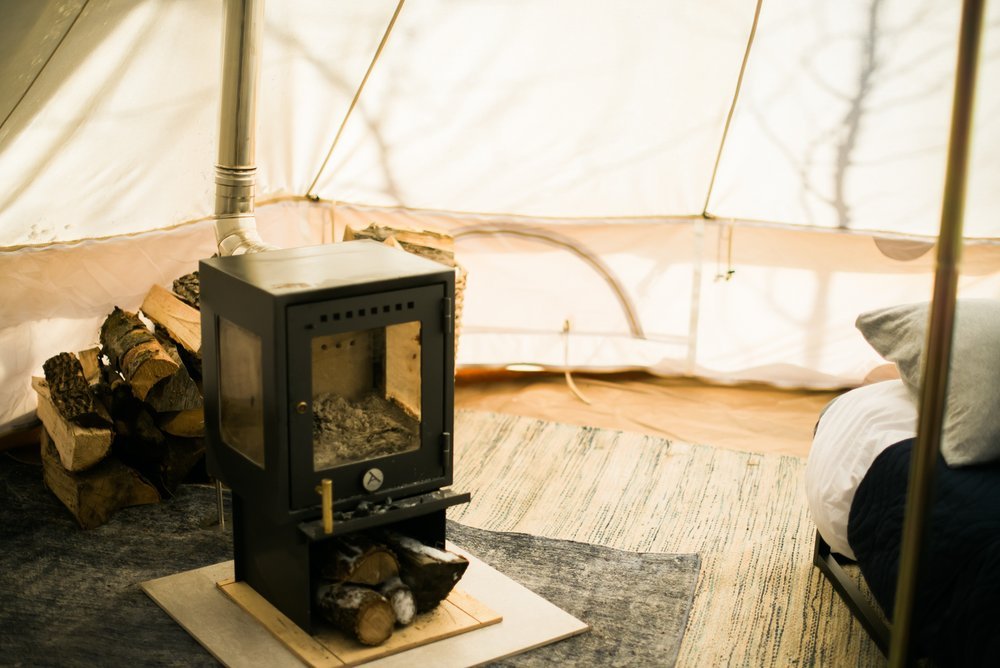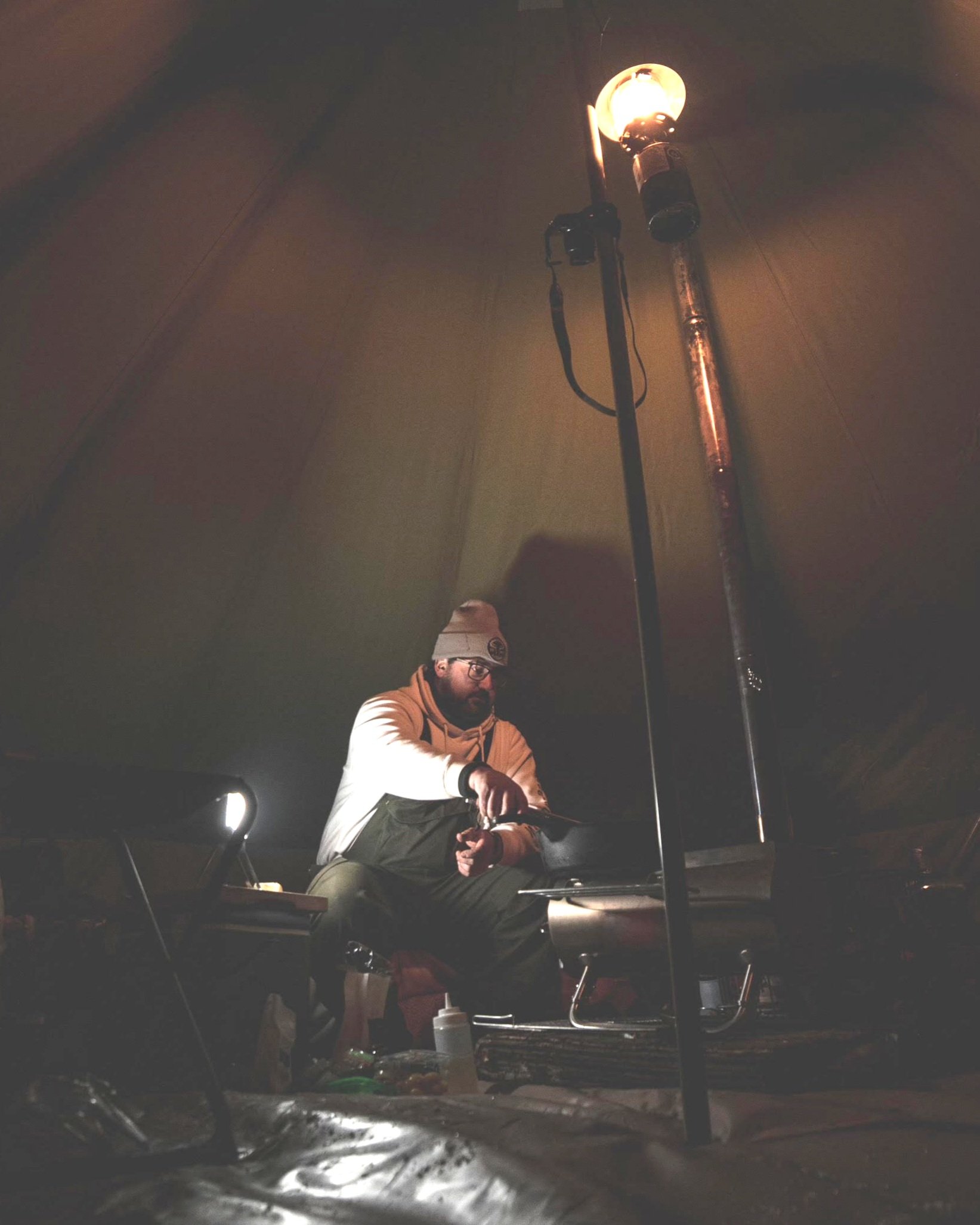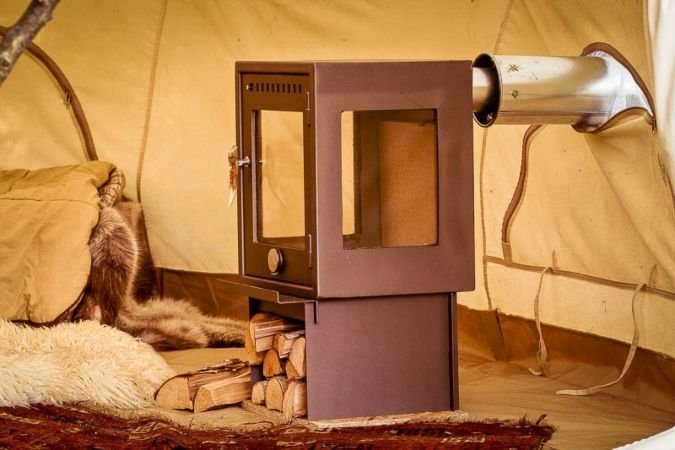The features of a tent stove can be overwhelming – from air baffles to air wash systems. If you’re considering purchasing a stove and don’t know where to start, here are the answers to the questions we get the most.
What stove should I buy?
We have two types of tent stoves: portable stoves and glamping stoves. Here are the factors you need to consider:
- Weight vs portability
- Refuelling maintenance
Now, let us ask you a question. How will you be using your stove? Do you plan on taking it into the backcountry or just on the occasional trip out with vehicle access?
You should sway portable if you’re heading deep into the woods.

Both our portable and glamping stoves put out about the same amount of heat. What you actually need to consider is how often you’re going to have to refuel.
Our portable stoves just fit standard-length firewood but you will still need to splinter the wood. Our glamping stoves, however, can fit up to three logs with little work involved.

Photo by Alyssa Dueck, @borealplainsmb
So, you can expect to stoke the fire in a portable stove every 30 minutes or so, whereas our glamping stoves can last up to about 60 minutes (depending upon a few factors). Other portable stoves on the market — like the G Stove — while mighty, can be tough in the winter because of the small firebox.

2. What tent is best for a stove?
Any of our canvas tents can be used. The general rule of thumb to maximize heat output: the smaller and thicker the tent, the warmer you will stay. For example, our 400 Pro and 400 ProTech models are great options — big enough to store your gear but small enough to maximize heat efficiency. The conical shape of our bell tents — versus walled tents — also supports heat efficiency, as there is less ‘dead’ air without compromising the size of the footprint.
3. Can you sell a tent with a pre-made hole?
We know it can be scary to cut a hole in your tent, but you don’t want a tent with a pre-cut hole, trust us. If you install a modular stove jack yourself, you have way more flexibility in many ways. Most importantly, you’re not restricted to the kind of stove you need to buy.
4. How do you cut a stove jack hole in your tent?
Here, we take you through the not-so-scary steps.
STEP 1: DECIDE WHERE THE JACK WILL BE INSTALLED.
Where you place your hole affects how you’ll be heating your tent.
For instance, if you’re looking at a portable stove and keen on camping in, say, -15 degrees, you’re going to want to place the stove closer to the middle of the tent, as this will distribute the heat more evenly, and you will get the ambient heat off of the flue kit. Portable tent stoves — like the Winnerwell Woodlander and Winnerwell Nomad — typically have vertical exits to maximize heat output from both the stove and the radiant heat from the flue kit.

Photo by Will Harrison, @bushcraft.canadian

Photo by Panoramic Outdoors, @panoramic_outdoors
Glamping stoves — like the Bison Stove — can be vented horizontally through the tent window (with a double-insulated flue) because the larger firebox typically emits a sufficient amount of heat that it doesn’t have to rely on the heat transfer from its flue kit.

Photo by CanvasCamp, @CanvasCamp
Important note: you may have to cut the rubber of the jack to fit your flue. Make sure to measure twice (using the flue) and cut once to snugly fit the pipe.
STEP 2: MARK WHERE THE HOLE WILL GO.
This is when the fun begins. Our friends at CanvasCamp created a 10-minute step-by-step video on how to install a stove jack in one of our tents. We couldn’t have said it better ourselves, so why try? (Hot tip: skip to the 5-minute mark if you already have a grasp on stove basics). If you’re looking for the 2-minute primer, fellow citizen @bushcraft.canadian (aka Will Harrison), an avid outdoorsman in the Canadian Rockies, walks us through this below.
First, using a pencil, trace both the internal and external rings of the jack while also marking each of the holes where the screws will go. Next, use a sharp knife or, if you want to get fancy, a professional hole punch (think leather work), make the holes for the screws.
At this point, you have two options: A) cut the hole, or B) pre-install the jack first before cutting the hole. We recommend option B (and so does CanvasCamp) since the jack provides support when cutting the hole. That said, you may need a second person using this approach. Or, as CanvasCamp shares, you can always roll up the side walls and try to maneuver it by yourself if you feel confident in your coordination.
Either way, when you cut the hole, CanvasCamp recommends first puncturing the fabric with a sharp knife, then cutting an “X” into the fabric, to then cut the full circle.
First, using a pencil, trace both the internal and external rings of the jack while also marking each of the holes where the screws will go. Next, use a sharp knife or, if you want to get fancy, a professional hole punch (think leather work), make the holes for the screws.
At this point, you have two options: A) cut the hole, or B) pre-install the jack first before cutting the hole. We recommend option B (and so does CanvasCamp) since the jack provides support when cutting the hole. That said, you may need a second person using this approach. Or, as CanvasCamp shares, you can always roll up the side walls and try to maneuver it by yourself if you feel confident in your coordination.
Either way, when you cut the hole, CanvasCamp recommends first puncturing the fabric with a sharp knife, then cutting an “X” into the fabric, to then cut the full circle.

STEP 2: UNSCREW THE PLATES AND REMOVE THE OUTSIDE PLATE.
STEP 3: SET THE JACK (WITH ONE RING REMOVED) ON THE OUTSIDE OF THE TENT.
You may be able to maneuver the jack through the tent if you went with option A, pre-cutting the hole.
STEP 4: SCREW THE OUTSIDE PLATE BACK ON.
Make sure it is snug as a bug.
Et voila!
You could also consider a stove fan to more evenly distribute the heat throughout your tent, and to avoid having the heat automatically rise/leave your tent. Will recommends checking out the Ecofan, developed in the Bruce Peninsula in Ontario.
5. What do I do with the hole in the tent when not using the stove and jack?
There are several approaches to covering the hole, from sticking a cup in the jack (if you want a quick/cheap solution) to purchasing a CanvasCamp fireproof stove flap that can be sewn. You can find that more sophisticated solution here (we will be selling this in Canada by December 2022!). However, we recommend simply removing the rubber and placing a piece of fabric in between the two metal rings.


